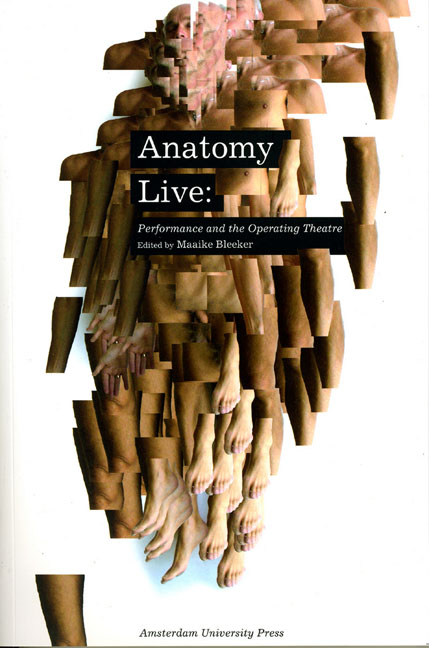Book contents
- Frontmatter
- Contents
- Acknowledgements
- Prologue - Men with Glass Bodies
- Introduction
- Performance Documentation 1: Holoman; Digital Cadaver
- Digital Cadavers and Virtual Dissection
- ‘Who Were You?’: The Visible and the Visceral
- Performance Documentation 2: Excavations: Fresh but Rotten
- The Anatomy Lesson of Professor Moxham
- ‘Be not Faithless But Believing’: Illusion and Doubt in the Anatomy Theatre
- Performance Documentation 3: De Anatomische Les
- Of Dissection and Technologies of Culture in Actor Training Programs – an Example from 1960s West Germany
- Ocular Anatomy, Chiasm, and Theatre Architecture as a Material Phenomenology in Early Modern Europe
- Performance Documentation 4: Camillo – Memo 4.0: The Cabinet of Memories – A Tear Donnor Session
- Martin, Massumi, and the Matrix
- Performance Documentation 5: Sensing Presence no 1: Performing a Hyperlink System
- ‘Where Are You Now?’: Locating the Body in Contemporary Performance
- Performance Documentation 6: Under My Skin
- Anatomies of Live Art
- Performance Documentation 7: Crash
- Restaging the Monstrous
- Delirium of the Flesh: ‘All the Dead Voices’ in the Space of the Now
- Performance Documentation 8: Körper
- Operating Theatres: Body-bits and a Post-apartheid Aesthetics
- Index
Performance Documentation 4: Camillo – Memo 4.0: The Cabinet of Memories – A Tear Donnor Session
Published online by Cambridge University Press: 10 February 2021
- Frontmatter
- Contents
- Acknowledgements
- Prologue - Men with Glass Bodies
- Introduction
- Performance Documentation 1: Holoman; Digital Cadaver
- Digital Cadavers and Virtual Dissection
- ‘Who Were You?’: The Visible and the Visceral
- Performance Documentation 2: Excavations: Fresh but Rotten
- The Anatomy Lesson of Professor Moxham
- ‘Be not Faithless But Believing’: Illusion and Doubt in the Anatomy Theatre
- Performance Documentation 3: De Anatomische Les
- Of Dissection and Technologies of Culture in Actor Training Programs – an Example from 1960s West Germany
- Ocular Anatomy, Chiasm, and Theatre Architecture as a Material Phenomenology in Early Modern Europe
- Performance Documentation 4: Camillo – Memo 4.0: The Cabinet of Memories – A Tear Donnor Session
- Martin, Massumi, and the Matrix
- Performance Documentation 5: Sensing Presence no 1: Performing a Hyperlink System
- ‘Where Are You Now?’: Locating the Body in Contemporary Performance
- Performance Documentation 6: Under My Skin
- Anatomies of Live Art
- Performance Documentation 7: Crash
- Restaging the Monstrous
- Delirium of the Flesh: ‘All the Dead Voices’ in the Space of the Now
- Performance Documentation 8: Körper
- Operating Theatres: Body-bits and a Post-apartheid Aesthetics
- Index
Summary
In 1998 Emil Hrvatin presented his installation Camillo – Memo 4.0: The Cabinet of Memories – A Tear Donnor Session at the Slovenian National Theatre Museum. Hrvatin reconceptualized the idea of the Theatre of Memory, as developed by Giulio Camillo. According to Hrvatin, Camillo is ‘a paradigm of the free mind, the innovator of the theatre, an installation artist in the age of Renaissance, and someone who knew how to conceive the net-like, combinatory nature of communication’ (Hrvatin quoted in Žerovnik, 2003, p. 126). Hrvatin's installation explored the relationships between visibility and knowledge, individuality and society, and, first and foremost, the relationship between body and mind. Visitors to The Cabinet of Memories were kindly asked to donate their tears. This was accomplished by recalling memories — in order to materialize their memories, to embody their thoughts.
The following quotes from visitors to The Cabinet of Memories both describe and reflect upon the spectator's position within the installation.
‘The installation/performance Camillo Memo 4.0: The Cabinet of Memories – A Tear Donnor Session (…) is conceived as a private tear-jerker. A tear-jerker in a very literal and direct sense, since the spectators are actually expected to donate their tears. Hrvatin built a glass tear receptacle, in which they can collect the tears that they are willing to shed. To stimulate the production of tears, the spectators are invited into one of three boxes. In the Cabinet of Individual Memory, they find only a mirror with which they can confront themselves with painful memories. Every spectator is invited to re-enact scenes from his or her past that could generate a stream of sorrow. If successful, they are rewarded with a Golden Certificate because, in this installation, an individual crying is understood to be the most valuable form of emotion memory. Individual spectators who have difficulty shedding tears ‘on personal command’ can try their luck in the Cabinet of Collective Memory. This cabinet is equipped with video and television screens from which the spectator can choose his or her favourite tear-jerking scene. These devices of emotional self-stimulation offer several collective “climaxes” which are supposed to make you cry for joy or bitterness. (…) If successful, you are awarded a Silver Certificate.
- Type
- Chapter
- Information
- Anatomy LivePerformance and the Operating Theatre, pp. 147 - 150Publisher: Amsterdam University PressPrint publication year: 2008



